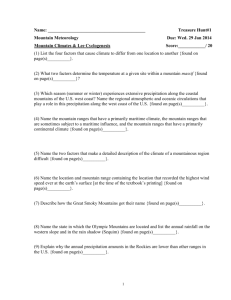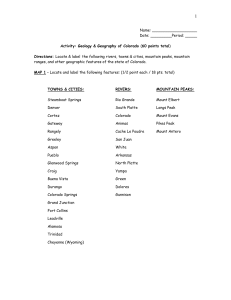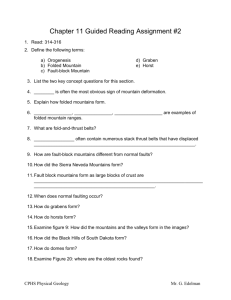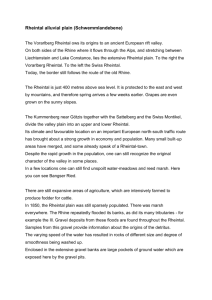Mountains Follow Up
advertisement
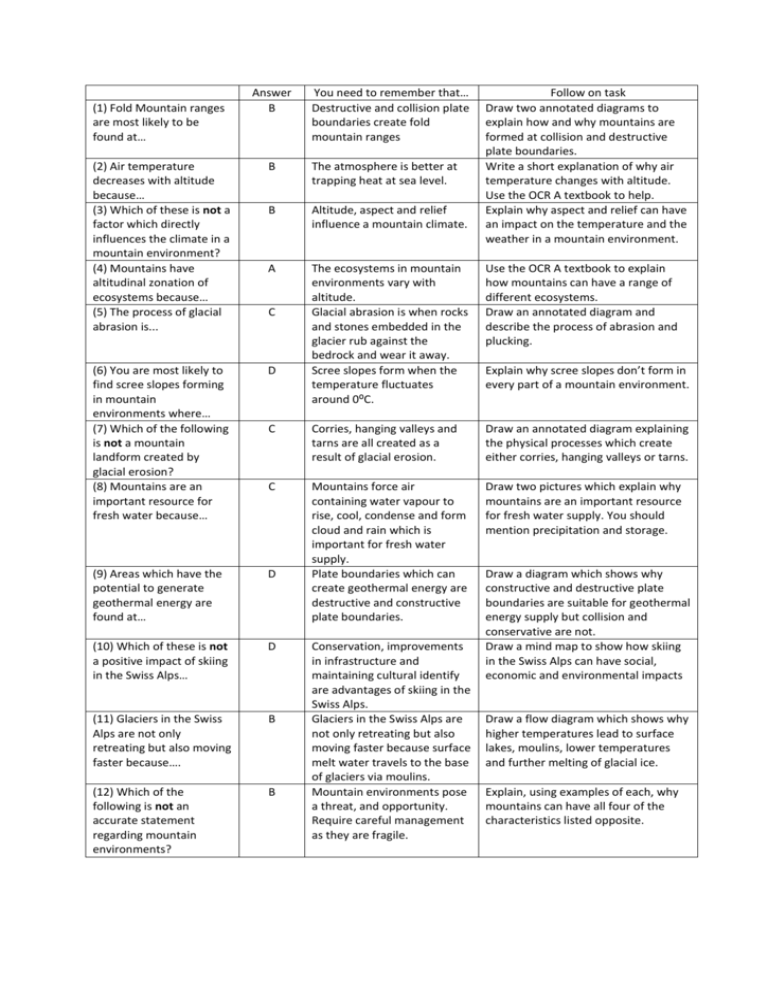
(1) Fold Mountain ranges are most likely to be found at… (2) Air temperature decreases with altitude because… (3) Which of these is not a factor which directly influences the climate in a mountain environment? (4) Mountains have altitudinal zonation of ecosystems because… (5) The process of glacial abrasion is... Answer B You need to remember that… Destructive and collision plate boundaries create fold mountain ranges Follow on task Draw two annotated diagrams to explain how and why mountains are formed at collision and destructive plate boundaries. Write a short explanation of why air temperature changes with altitude. Use the OCR A textbook to help. Explain why aspect and relief can have an impact on the temperature and the weather in a mountain environment. B The atmosphere is better at trapping heat at sea level. B Altitude, aspect and relief influence a mountain climate. A The ecosystems in mountain environments vary with altitude. Glacial abrasion is when rocks and stones embedded in the glacier rub against the bedrock and wear it away. Scree slopes form when the temperature fluctuates around 0⁰C. Use the OCR A textbook to explain how mountains can have a range of different ecosystems. Draw an annotated diagram and describe the process of abrasion and plucking. C Corries, hanging valleys and tarns are all created as a result of glacial erosion. Draw an annotated diagram explaining the physical processes which create either corries, hanging valleys or tarns. C Mountains force air containing water vapour to rise, cool, condense and form cloud and rain which is important for fresh water supply. Plate boundaries which can create geothermal energy are destructive and constructive plate boundaries. Draw two pictures which explain why mountains are an important resource for fresh water supply. You should mention precipitation and storage. C (6) You are most likely to find scree slopes forming in mountain environments where… (7) Which of the following is not a mountain landform created by glacial erosion? (8) Mountains are an important resource for fresh water because… D (9) Areas which have the potential to generate geothermal energy are found at… D (10) Which of these is not a positive impact of skiing in the Swiss Alps… D (11) Glaciers in the Swiss Alps are not only retreating but also moving faster because…. B (12) Which of the following is not an accurate statement regarding mountain environments? B Conservation, improvements in infrastructure and maintaining cultural identify are advantages of skiing in the Swiss Alps. Glaciers in the Swiss Alps are not only retreating but also moving faster because surface melt water travels to the base of glaciers via moulins. Mountain environments pose a threat, and opportunity. Require careful management as they are fragile. Explain why scree slopes don’t form in every part of a mountain environment. Draw a diagram which shows why constructive and destructive plate boundaries are suitable for geothermal energy supply but collision and conservative are not. Draw a mind map to show how skiing in the Swiss Alps can have social, economic and environmental impacts Draw a flow diagram which shows why higher temperatures lead to surface lakes, moulins, lower temperatures and further melting of glacial ice. Explain, using examples of each, why mountains can have all four of the characteristics listed opposite.



